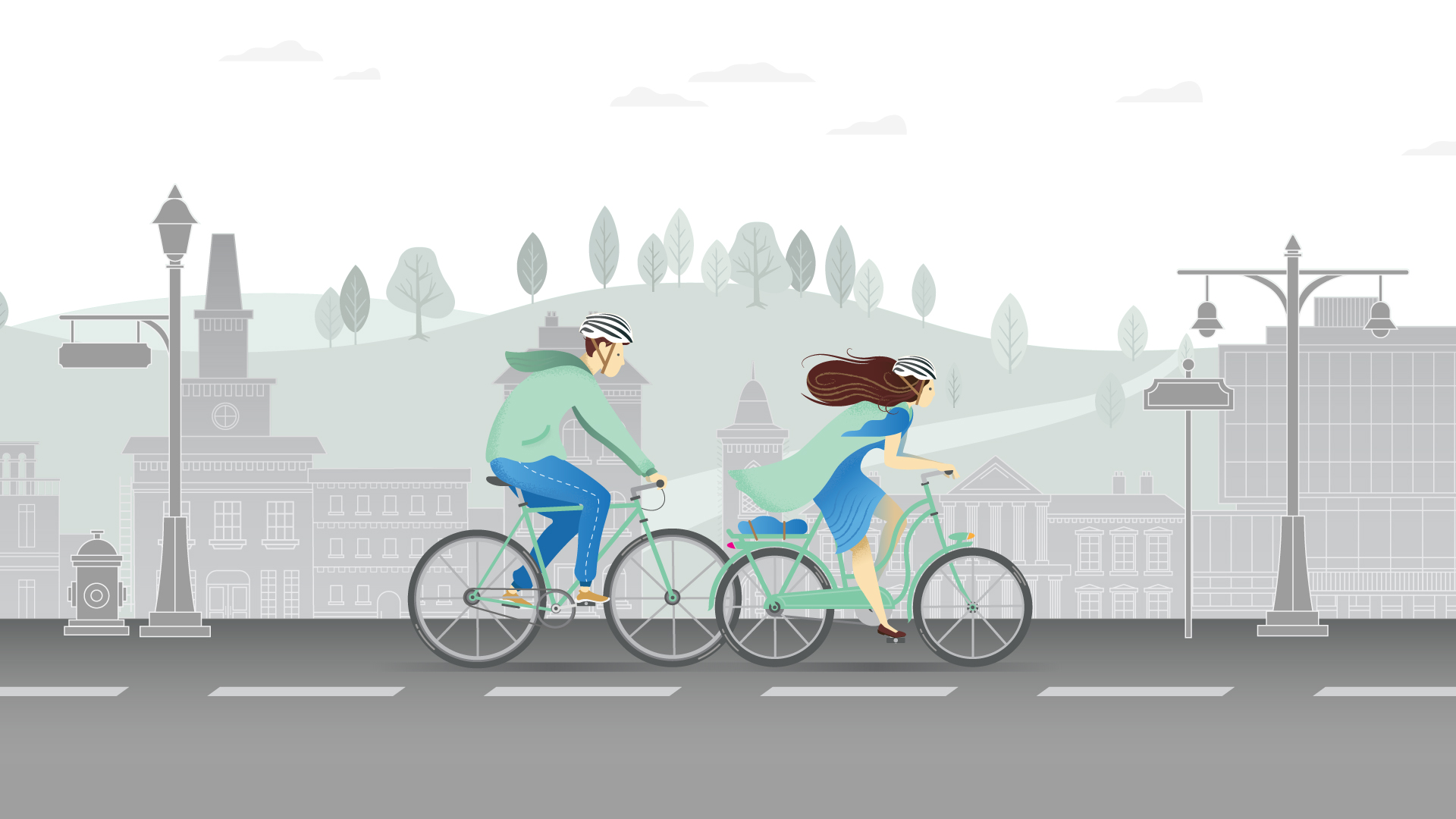Dear Hamilton LRT team,
On behalf of our membership and the thousands of cyclists represented collectively by our organizations, we are writing to express our concerns regarding the proposed changes to existing and planned cycling lanes along the LRT route. After highlighting our overall concerns with the impacts of this shift away from the broader premise of active transportation that LRT is built upon, this submission outlines our concerns along specific areas of the route. It concludes with some suggested opportunities for the City of Hamilton and Metrolinx to consider as you move forward towards community and neighbourhood consultations.
Shifting away from active transportation
As Hamilton LRT’s Public Information Centre 2 report notes, “Rapid Transit is more than just moving people from place to place. It is about providing a catalyst for the development of high quality, safe, sustainable and affordable transportation options” (p4). This same report also notes that the Metrolinx Regional Transportation Plan “articulates a vision for all modes of transportation in the region” (our emphasis added) and reinforces the need to integrate LRT with pedestrian and cycling infrastructure. Unfortunately, the changes proposed along the LRT route—those aimed at accommodating the status quo traffic flow of single-use occupancy vehicles—don’t add up to the ambitious goals of creating a more sustainable and active transportation network that LRT has been built upon. We understand that the LRT project is moving forward in an unsettling political climate exerting pressures to cater to the status quo, but we are deeply concerned that by removing cycling lanes to improve motor vehicle traffic flow, we will waste the opportunity for transformative change that Metrolinx and the City of Hamilton propose to be striving towards. As our community, our province, our country, and the world continue to face the unnerving realities of climate change, it is especially disappointing to see that single-occupancy automobiles are being catered to over more sustainable and healthy transportation options. If the LRT project is truly about “improving the quality of life for our community and the surrounding environment”, this shift in strategy falls well short of our aspirations.
We also question the unspoken assumptions regarding the demand for automobile capacity on our roads after LRT has been built. The purpose of LRT is not just to improve the efficiency, quality, and reliability of public transit for people who currently use it. Rather, LRT promises to create a modal shift that will reduce the number of single-occupancy vehicles on our streets. Part of this shift will include single-occupancy vehicles and delivery vehicles adjusting their routes to avoid areas of high congestion—such as the areas identified for removal of planned and existing bike lanes. For these reasons, we don’t agree that the expected problem of missing lane capacity is a proper reason to talk about removing existing or planned cycling infrastructure on a project meant to improve active transportation on the whole.
Specific Concerns
While we are concerned with the overall shift away from active transportation network integration proposed by the LRT project, we have some very specific concerns regarding the current proposed plans. These include:
- Removal of Main St. W. Cycling Lanes: Part of the original LRT proposal, these lanes have been removed completely from plans between McMaster University and Highway 403. While the map provided in the Public Information Centre 2 slides notes that there is willingness to explore alternative routes, both of the routes noted (through Westdale and Ainslie Wood) are already cycling routes. This change results in a net loss of proposed infrastructure.
- Status Quo on Highway 403 Overpass: While we are very happy that the City’s cycling infrastructure currently includes protected two-way cycling tracks on both Main St. W. and King St. W., it must be noted that both of these routes require cyclists to cross either an onramp or an offramp from a 400-series highway. We would hope that given the resources being allocated to this project, and the vision of improving transportation options for all, this safety concern would be top of mind in plans to adapt and change the overall traffic flow in this corridor.
- Dundurn St. N. & York Blvd. Bike Lane Removal: These lanes comprise the major cycling route between Westdale and Downtown Hamilton. Removing these lanes in favour of improved automobile traffic flow goes directly against the LRT vision of “safe, sustainable and affordable transportation options” and speaks to the ongoing challenges that cyclists have in our city to be seen as a valued and respected form of transportation. One only needs to look at Hamilton’s Cycling Master Plan and the fact that it is incredibly underfunded and decades behind schedule to understand how often cyclists’ safety and value as citizens is neglected. Finally, as LRT is meant to be integrated with active transportation options at each hub, the removal of bike lanes would mean that cyclists arriving to the LRT by bike would have to dismount and then walk an additional distance to reach the hub—not ideal for a system that is aiming for seamless integration of transportation modes.
- Centre-East Lower City: The centre-east lower city boasts two safe east-west cycling routes along Cannon and Lawrence/Cumberland. However, there are no designated or improved north-south routes linking these to the proposed LRT system. Moreover, the SoBi bikeshare system has been implemented much more sparsely between Wentworth and Ottawa Streets and does not serve the area from Ottawa St. to the Queenston Traffic Circle.
- Larger Systems Implications of Proposed Changes: Hamilton’s cycling network is vastly underfunded and many of the existing pieces of infrastructure along the LRT corridor have come to fruition only after a great deal of effort from citizens and neighbourhood groups. One such piece of infrastructure is the Cannon St. Cycle Track. As plans develop, we are concerned that proposed removal of cycling infrastructure along the Dundurn/York corridor may also extend to Cannon St. The Cannon St. cycle track is the only safe east-west cycling route through the north central lower city; its removal would be catastrophic for cyclists and would send an unwanted message that cyclists’ needs do not matter in Hamilton.
Opportunities
Aligned with the concerns listed above, we would like to propose some possible opportunities to better integrate cycling into planning as the LRT project moves forward. These include:
- Main St. W. Cycling Lanes: Reflecting the overall vision of the LRT project, we encourage Metrolinx and the City of Hamilton to consider the need to balance the use of the roadway for all transportation options as per the vision of this project. Please consider the number of schools along this route (n=4) and the number of children and young people who cannot drive but may be much more likely to be active and healthy given the option. As the LRT office consults on cycling plans, we encourage you to consult with these stakeholders. Of special interest would be feedback from McMaster University students who may be more likely to travel downtown and integrate further with the City were there safe options to do so via bicycle.
- Highway 403 Overpass: Consider building a protected 2-way cycle track onto the new LRT bridge that could link to infrastructure along the Dundurn corridor (see below). Given the resources being put towards the bridge already, additional space for a protected (and maintained) cycle track would address safety concerns of existing routes. Alternatively, construct overpasses or underpasses along existing routes to provide safe crossing for cyclists and pedestrians.
- Dundurn Corridor: Fund and develop a protected cycle track and greenway that travels through Cathedral Park and connects to Frid St. to the south and Breadalbane St. and Woodbine Crescent to the north. Ensure a safe and direct cycling route that arrives at the Dundurn LRT stop.
- York & Dundurn Intersection: Create a two-way cycle track along York Blvd. that connects the existing Cannon Cycle Track with a greenway route on Woodbine Crescent. Expanding the intersection at York and Dundurn could allow for a cycling-specific signal crossing to allow cyclists to cross safely from Woodbine Crescent to a York Blvd. cycle track.
- Centre-East Lower City: Improve north-south cycling routes to LRT stops, including safer crossings of Main St. Connect Scott Park station directly to Cannon St. bicycle lanes via multi-use path across proposed HWDSB high school property at the Scott Park site. Expand SoBi service area beyond Queenston Traffic Circle with equivalent station density to west and central Hamilton.
- Larger Systems Implications: Be open and transparent about additional changes being considered (if at all) along and near other areas of the route. For example, if changes to Main St. W. are being considered, ensure that neighbourhoods and the community are aware of this possibility, as this option could include a two-way cycle track or protected bike lanes along any conversion of Main St. W. to two-way.
Let’s Be Bold
We are incredibly supportive of the overall vision of LRT to be an incredibly positive game-changer for the City of Hamilton. The vision of developing a truly integrated and sustainable transportation network is one that we as a community need to hold high and strive towards. By removing existing active transportation options we would be falling short of this goal and catering to short-sighted ideals of single-use vehicles as the status quo. LRT is meant to change this, let’s be bold in sticking to this vision.
While we have outlined our concerns above, we are very encouraged to see that there are plans for further consultations and discussion with residents, neighbourhoods, and Hamilton’s cycling community (we should note that we also hope drivers, transit users, and pedestrians will be part of this conversation). We offer these ideas as suggestions to initiate dialogue, and realize that others will be bringing forward alternative ideas that may also be possible solutions to consider. We very much look forward to hearing more about these consultations, and hope that they can serve as a catalyst for creative thinking, respectful dialogue, and the development of visionary approaches to the complex challenges outlined in the most recent LRT update.
We would be happy to not only participate in this session, but to work with the LRT team to facilitate and follow-up on ideas raised as they relate to Hamilton’s cycling network. We would also be open to hosting the LRT planning team and city planners on a ride along the impacted routes to provide a first-person perspective on existing infrastructure and the importance of providing safe, healthy, and sustainable transportation options for all. Perhaps this could be included as part of the consultations in the coming months.
Thank you for considering the ideas within and we look forward to hearing from you.
Sincerely,
Dave Heidebrecht
Chair, Cycle Hamilton
On behalf of the Cycle Hamilton Board of Directors
Mark Chamberlain, Ned Nolan, Kate Whalen, Johanna Bleecker, Chelsea Cox, Lynda Lukasik, and John Neary

